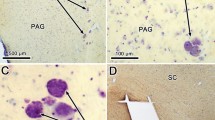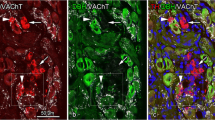Abstract
Previous studies reported that the activity of trigeminal motoneurons innervating masseter muscles is modulated by vestibular inputs. We performed the present study to provide an anatomical substrate for these physiological observations. The transynaptic retrograde tracer pseudorabies virus-Bartha was injected into multiple sites of the lower third of the superficial layer of the masseter muscle in rats, a subset of which underwent a sympathectomy prior to virus injections, and the animals were euthanized 24–120 h later. Labeled masseteric motoneurons were first found in the ipsilateral trigeminal motor nucleus following a 24-h postinoculation period; subsequent to 72-h survival times, the number of infected motoneurons increased, and at ≥96 h many of these cells showed signs of cytopathic changes. Following 72-h survival times, a few transynaptically labeled neurons appeared bilaterally in the medial vestibular nucleus (MVe) and the caudal prepositus hypoglossi (PH) and in the ipsilateral spinal vestibular nucleus (SpVe). At survival times of 96–120 h, labeled neurons were consistently observed bilaterally in all vestibular nuclei (VN), although the highest concentration of infected cells was located in the caudal part of the MVe, the SpVe, and the caudal portion of PH. The distribution and density of labeling in the VN and PH were similar in sympathectomized and nonsympathectomized rats. These anatomical data provide the first direct evidence that neurons in the VN and PH project bilaterally to populations of motoneurons innervating the lower third of the superficial layer of the masseter muscle. The MVe, PH, and SpVe appear to play a predominant integrative role in producing vestibulo-trigeminal responses.



Similar content being viewed by others
References
Aston-Jones G, Card P (2000) Use of pseudorabies virus to delineate multisynaptic circuits in brain: opportunities and limitations. J Neurosci Methods 103:51–61
Bartha A (1961) Experimental reduction of virulence of Aujezky’s disease. Magy Allatorov Lapja 16:42–45
Buisseret-Delmas C, Compoint C, Delfini C, Buisseret P (1999) Organisation of reciprocal connections between trigeminal and vestibular nuclei in the rat. J Comp Neurol 409:153–168
Card JP (1998) Practical considerations for the use of pseudorabies virus in transneuronal studies of neural circuitry. Neurosci Biobehav Rev 22:685–694
Card JP, Whealy ME, Robbins AK, Enquist LW (1992) Pseudorabies virus envelope glycoprotein gI influences both neurotropism and virulence during infection of the rat visual system. J Virol 66:3032–3041
de Olmos J, Hardy H, Heimer L (1978) The afferent connections of the main and the accessory olfactory bulb formations in the rat: an experimental HRP-study. J Comp Neurol 181:213–244
Deriu F, Podda MV, Chessa G, Tolu E (1999) Trigeminal integration of vestibular and forelimb nerve inputs. Arch Ital Biol 137:63–73
Deriu F, Podda MV, Milia M, Chessa G, Sau G, Pastorino M, Aiello I, Tolu E (2000) Masseter muscle activity during vestibular stimulation in man. Arch Ital Biol 138:205–215
Deriu F, Tolu E, JC Rothwell (2003) A short latency vestibulomasseteric reflex evoked by electrical stimulation over the mastoid in healthy humans. J Physiol 553.1:267–279
Deriu F, Tolu E, JC Rothwell (2005) A sound-evoked vestibulomasseteric reflex in healthy humans. J Neurophysiol 93:2739–2751
Donga R, Lund JP (1991) Discharge patterns of trigeminal commissural last-order interneurons during fictive mastication in the rabbit. J Neurophysiol 66:1564–1578
Eriksson PO (1982) Muscle-fibre composition of the human mandibular locomotor system. Enzyme-histochemical and morphological characteristics of functionally different parts. Swed Dent J 12:1–44
Eriksson PO, Thornell LE (1983) Histochemical and morphological muscle-fibre characteristics of the human masseter, the medial pterygoid and the temporal muscles. Arch Oral Biol 28:781–795
Fay RA, Norgren R (1997) Identification of rat brainstem multisynaptic connections to the oral motor nuclei using pseudorabies virus I. Masticatory muscle motor systems. Brain Res Rev 25:255–275
Godeaux E, Desmedt JE (1975) Human masseter muscle: H-and tendon reflexes. Arch Neurol 32:229–234
Herring SW, Grimm AF, Grimm BR (1979) Functional heterogeneity in a multipinnate muscle. Am J Anat 154:563–576
Hickenbottom RS, Bishop B, Moriarty MT (1985) Effects of whole body rotation on masseteric motoneuron excitability. Exp Neurol 89:442–453
Hofstetter CP, Card JP, Olson L (2005) A spinal cord pathway connecting primary afferents to the segmental sympathetic outflow system. Exp Neurol 194:128–138
Hsu SM, Raine L, Fanger H (1981) Use of avidin-biotin-peroxidase complex (ABC) in immunoperoxidase techniques: a comparison between ABC and unlabeled antibody (PAP) procedures. J Histochem Cytochem 29:577–580
Inoue T, Masuda Y, Nagashima T, Yoshikawa K, Morimoto T (1992) Properties of a rhythmically active reticular neurons around the trigeminal motor nucleus during fictive mastication in the rat. Neurosci Res 14:275–294
Inoue M, Nozawa-Inoue K, Donga R, Yamada Y (2002) Convergence of selected inputs from sensory afferents to trigeminal premotor neurons with possible projections to masseter motoneurons in the rabbit. Brain Res 957:183–191
Kamogawa H, Manabe K, Kondo M, Naito K (1994) Supra- and juxtatrigeminal inhibitory premotor neurons with bifurcating axons projecting to masseter motoneurons on both sides. Brain Res 639:85–92
Kevetter G, Leonard R, Newlands S, Perachio A (2004) Central distribution of vestibular afferents that innervate the anterior or lateral semicircular canal in the mongolian gerbil. J Vestib Res 14:1–15
Kolta A, Westberg KG, Lund JP (2000) Identification of brainstem interneurons projecting to the trigeminal motor nucleus and adjacent structures in the rabbit. J Chem Neuroanat 19:175–195
Li YQ, Takada M, Kaneko T, Mizuno N (1995) Premotor neurons for trigeminal motor nucleus neurons innervating the jaw-closing and jaw-opening muscles-differential distribution in the lower brainstem of the rat. J Comp Neurol 356:563–579
Lovick TA, Wolstencroft JH (1983) Projections from brainstem nuclei to the spinal trigeminal tractus in the cat. Neuroscience 9:411–420
Marfurt CF, Raichert DM (1991) Trigeminal primary afferent projections to “non-trigeminal” areas of the rat central nervous system. J Comp Neurol 196:173–187
McCrea RA, Baker R (1985) Anatomical connections of the nucleus prepositus of the cat. J Comp Neurol 237:377–407
McCrea RA, Baker R, Delgado-Garcia J (1979) Afferent and efferent organization of the prepositus hypoglossi nucleus. Prog Brain Res 50:653–665
McLean IW, Nakane PK (1974) Periodate-lysine-paraformaldehyde for immunoelectron microscopy. J Histochem Cytochem 22:1077–1083
Mizuno N, Konishi A, Sato M (1975) Localization of masticatory motoneurons in the cat and rat by means of retrograde axonal transport of horseradish peroxidase. J Comp Neurol 164:105–115
Mizuno N, Yasui Y, Nomura S, Itoh K, Konishi A, Takada M, Kudo M (1983) A light and electron microscopic study of premotor neurons for the trigeminal motor nucleus. J Comp Neurol 215:290–298
Nozaki S, Iriki A, Nakamura Y (1986a) Role of corticobulbar projection neurons in cortically induced rhythmical masticatory jaw-opening movement in the guinea pig. J Neurophysiol 55:826–845
Nozaki S, Iriki A, Nakamura Y (1986b) Localization of central rhythm generator involved in cortically induced rhythmical masticatory jaw-opening movement in the guinea pig. J Neurophysiol 55:806–825
Olsson KA, Landgren S, Westberg KG (1986) Location of, and peripheral convergence on, the interneuron in the disynaptic path from the coronal gyrus of the cerebral cortex to the trigeminal motoneurons in the cat. Exp Brain Res 65:83–97
Pfaller K, Arvidsson J (1988) Central distribution of trigeminal and upper cervical primary afferents in the rats studied by anterograde transport of horseradish peroxidase conjugated to wheat germ-agglutinin. J Comp Neurol 268:91–108
Rubertone JA, Mehler WR, Voogd J (1995) The vestibular nuclear complex. In: Paxinos G (ed) The rat nervous system. Academic, San Diego, pp 773–796
Sessle BJ (1977) Modulation of alpha and gamma trigeminal motoneurons by various peripheral stimuli. Exp Neurol 54:323–339
Shigenaga Y, Hirose Y, Yoshida A, Fukami H, Honma S, Bae YC (2000) Quantitative ultrastructure of physiologically identified premotoneuron terminals in the trigeminal motor nucleus in the cat. J Comp Neurol 426:13–30
Stålberg E, Eriksson PO, Antoni L, Thornell LE (1986) Electrophysiological study of size and fibre distribution of motor units in the human masseter and temporal muscles. Arch Oral Biol 31:521–527
Strick PL, Card JP (1992) Transneuronal mapping of neural circuits with alpha herpes viruses. In: Bolam JP (ed) Experimental neuroanatomy: a practical approach. Oxford University Press, Oxford, pp 81–101
Tolu E, Pugliatti M (1993) The vestibular system modulates masseter muscle activity. J Vest Res 3:163–171
Tolu E, Pugliatti M, Lacana P, Chessa G, Caria MA, Simula ME (1994) Vestibular and somatosensory afferents modulate masseter muscle activity. J Vest Res 4:303–311
Tolu E, Caria MA, Chessa G, Melis F, Simula ME, Podda MV, Solinas A, Deriu F (1996) Trigeminal motoneurone responses to vestibular stimulation in the guinea pig. Arch Ital Biol 134:141–151
Travers JB, Norgren R (1983) Afferent projection to the oral motor nuclei in the rat. J Comp Neurol 220:280–298
Valla J, Delfini C, Diagne M, Pinganaud G, Buisseret P, Buisseret-Delmas C (2003) Vestibulotrigeminal and vestibulospinal projections in rats: retrograde tracing coupled to glutamic acid decarboxylase immunoreactivity. Neurosci Lett 340:225–228
Vornov JJ, Sutin J (1983) Brainstem projections to the normal and noradrenergically hyperinnervated trigeminal motor nucleus. J Comp Neurol 214:198–208
Walberg F, Dietrics E, Nordby T (1985) On the projections from the vestibular and peryhypoglossal nuclei to the spinal trigeminal and lateral nuclei in the cat. Brain Res 133:123–130
Weijs WA (1996) Functional somatotopic organization of motoneurons supplying the rabbit masseter muscle. J Comp Neurol 364:279–289
Weijs WA, Jüch PJW, Kwa SHS, Korfage JAM (1993) Motor unit territories and fiber types in rabbit masseter muscle. J Dent Res 72:1491–1498
Westberg KG, Olsson KA (1991) Integration in trigeminal premotor interneurones in the cat. Functional characteristic of neurones in the subnucleus of the oral nucleus of the spinal trigeminal tract. Exp Brain Res 84:323–339
Westberg KG, Sandstrom G, Olsson KA (1995) Integration in trigeminal premotor interneurones in the cat. 3. Input characteristics and synaptic actions of neurons in subnucleus-gamma of the oral nucleus of the spinal trigeminal tract with a projection to the masseteric motoneurone subnucleus. Exp Brain Res 104:449–461
Westberg KG, Clavelou P, Sandstrom G, Lund JP (1998) Evidence that trigeminal brainstem interneurons form subpopulations to produce different forms of mastication in the rabbit. J Neurosci 18:6466–6479
Widmer CG, Lund JP (1989) Evidence that peaks in EMG averages can sometimes be caused by inhibition of motoneurons. J Neurol 62:212–219
Widmer CG, Klugman DK, English AW (1997) Anatomical partitioning and nerve branching patterns in the adult rabbit masseter. Acta Anat 159:222–232
Widmer CG, Carrasco DI, English AW (2003) Differential activation of neuromuscular compartments in the rabbit masseter muscle during different oral behaviors. Exp Brain Res 150:297–307
Yang M, Card JP, Tirabassi RS, Miselis RR, Enquist LW (1999) Retrograde, transneuronal spread of pseudorabies virus in defined neuronal circuitry of the rat brain is facilitated by gE mutations that reduce virulence. J Virol 73:4350–4359
Acknowledgements
Pseudorabies virus and anti-pseudorabies virus antibodies were the generous gift of Dr. Lynn Enquist of Princeton University. The authors thank Lucy Cotter, Jen-Shew Yen, and Bob Sabol for valuable technical assistance in completing this study. Funding was provided by Grants R01-DC003732 and R03-DC005911 from the National Institutes of Health (USA), as well as Ministero dell’ Università della Ricerca Scientifica e Tecnologica and Regione Autonoma della Sardegna (Italy).
Author information
Authors and Affiliations
Corresponding author
Rights and permissions
About this article
Cite this article
Giaconi, E., Deriu, F., Tolu, E. et al. Transneuronal tracing of vestibulo-trigeminal pathways innervating the masseter muscle in the rat. Exp Brain Res 171, 330–339 (2006). https://doi.org/10.1007/s00221-005-0275-8
Received:
Accepted:
Published:
Issue Date:
DOI: https://doi.org/10.1007/s00221-005-0275-8




